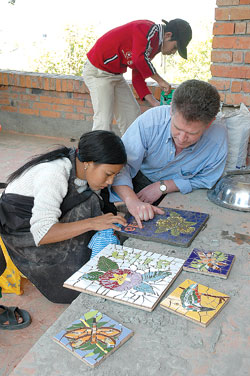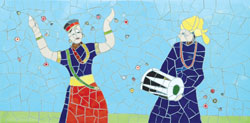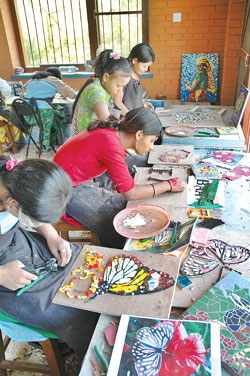|
|
A look of intense concentration on her face, Bimala turns her gaze from the wood framework she's filling in to the pile of colourful little pieces of bathroom tiles by her side. She selects a piece, cuts it deftly into the proper shape, slaps some glue onto its base, and sticks it into the final slot, completing her first mosaic. Bimala sits back, observes her handiwork and, smiles, satisfied with the pretty flower.
Just a few months ago, this shy 16-year-old was working in India's notorious Raj Kamal Circus, virtually enslaved.
In this sunny studio near Godavari, Bimala and eight other girls spend their days painstakingly creating mosaics for the virtually-untapped Nepali market. The patterns range from simple ones like the logo for the British Airport Authority, to complex designs with intricate patterns and colours schemes, derived from Mithila art. "I love making these," says Priya, echoing her friends here. "I could do this all day and not get tired."
It's a far cry from the physical and sexual exploitation the girls here were subject to in Indian circuses. "These girls are stigmatised. They are often rejected from their homes, and if restored to their parents, often end up as domestic help or prostitutes," says Lieutenant Colonel Philip Holmes, a retired dentist from the British Army. Holmes heads the Esther Benjamins Trust in Nepal, and was responsible for the rescue of these girls.
 The Trust has rescued 234 children from Indian circuses. Most are back with their families, but the slightly older children, and those who have been in the circuses for five to ten years, have difficulty adjusting to 'normal' life and, often, nowhere to go. Most reject school outright as an alternative-they have to start in grade one alongside six- and seven-year-olds, which they find humiliating.
The Trust has rescued 234 children from Indian circuses. Most are back with their families, but the slightly older children, and those who have been in the circuses for five to ten years, have difficulty adjusting to 'normal' life and, often, nowhere to go. Most reject school outright as an alternative-they have to start in grade one alongside six- and seven-year-olds, which they find humiliating.
"Teaching traumatised girls to sew and tailor clothes is an unproductive way of rehabilitation, as most aren't interested in such activities. Art is completely different," explains Holmes, who himself took up mosaic-making after he retired from the army. The years of long, taxing, often dangerous hours in the circuses have wreaked havoc on the girls' attention spans and self-esteem, but making art stimulates the imagination, the painstaking attention to detail is calming, and the whole process gives them confidence in themselves.
Today Priya and Reena, the first two girls that Philip taught, are experts-their tiles are perfectly placed in elaborate patterns and they use bold colour schemes. They now use Italian mosaic tiles made out of glass. The idea Holmes came up with seeing the enthusiasm of these two-asking donors to commission mosaics-has taken off, and the workshop provides both rehabilitation, and allows the girls to participate in the fundraising that made their rescue possible.
 A 30 by 30cm mosaic costs close to $100. The maker received Rs 500 and the rest goes to the trust. Bigger pieces cost more and the maker's share increases accordingly. Most girls complete about ten mosaics a month, earning Rs 5,000-more than most waiters, janitors, and clerks.
A 30 by 30cm mosaic costs close to $100. The maker received Rs 500 and the rest goes to the trust. Bigger pieces cost more and the maker's share increases accordingly. Most girls complete about ten mosaics a month, earning Rs 5,000-more than most waiters, janitors, and clerks.
Holmes believes that the mosaics could become a significant Nepali export, particularly, as more girls learn how to make them. He envisions 50 to 100 women, living in a large home-cum-studio of their own, and managing their own business.
The girls we spoke to were shy at first, but theit sharp awareness of the surroundings and the world shines through. For most, art is a way to regain their lost innocence and identities, to shine at their work and reclaim their place in society. 
An exhibition of the mosaics opens at the Summit Hotel on
25 March, which is also the 250th anniversary of the abolition by Britain of the slave trade. The show runs until 30 March, from 10AM-6PM daily.



